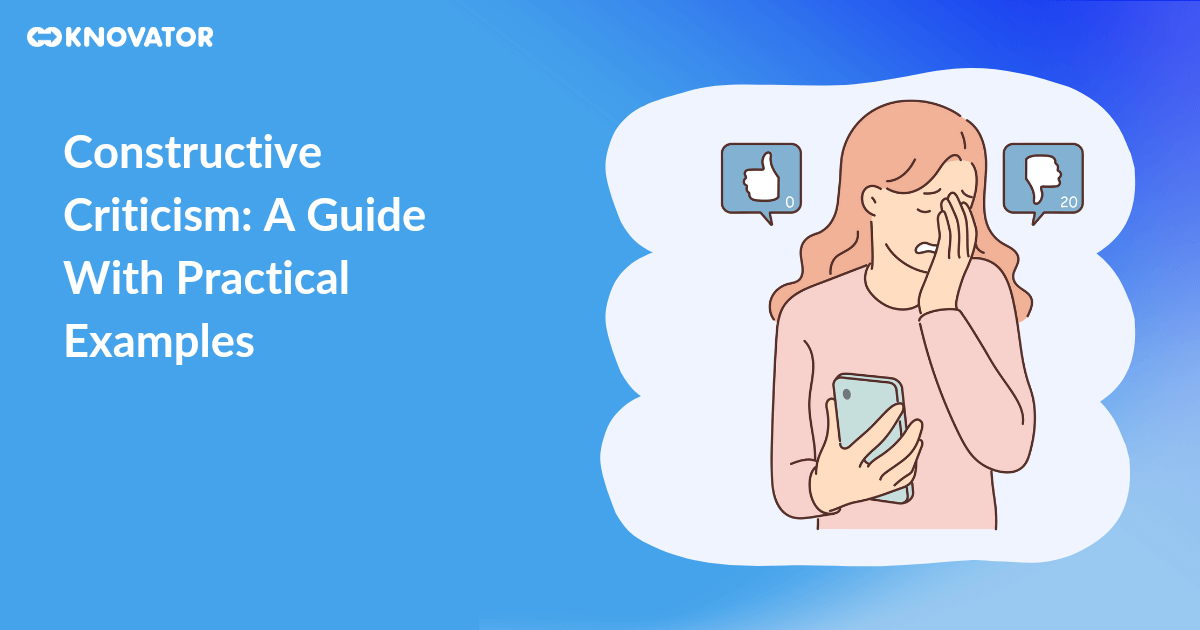Giving feedback is important for helping employees get better at their jobs. It’s simple when the feedback is positive, but what if you have to give advice or ask them to do things differently?
When you give advice and talk about things that need to improve, it can sometimes make people feel less excited, unhappy, and uninterested in what they’re doing. Think about improving your personal and work life – that’s where constructive criticism comes in.
If you are not good at constructive criticism as a manager, your team won’t grow. However, we have you covered. This guide is here to make constructive criticism easier to understand. It shows why it’s important and how to avoid mistakes along with real examples.
What is Constructive Criticism?

The key thing is to be respectful and kind. It’s not about making employees feel bad but helping them improve. Unlike destructive criticism, which can be mean and unhelpful, constructive criticism aims to uplift and guide.
Managers play a big role in giving constructive feedback. They need to encourage their team to get better without making them lose confidence. As a manager, you can do this by being specific about improvement and offering solutions.
Even though offering criticism might not be simple, it’s essential to make sure employees are happy and get chances to improve. Surprisingly, 83% of employees appreciate feedback, whether good or not-so-good.
As per Harvard Business Review, 72% of employees found feedback from their bosses most beneficial when questioned about their career growth. Employees seek feedback to improve, and offering constructive criticism allows managers to offer guidance and suggestions for improvement.
When is Constructive Criticism Appropriate?

- Rule Violations: When rules are broken or not followed, offering constructive feedback can guide individuals toward better choices.
- Ineffective Feedback: When previous attempts at feedback haven’t worked, constructive criticism can provide clearer guidance for improvement.
- Conflict Resolution: In conflicts or accidents, using dialogue instead of avoidance can help address issues through constructive criticism.
- Skill Growth: When someone needs to enhance their skills, constructive criticism offers specific advice for personal development.
- Impact on Others: If a behavior negatively affects the morale or productivity of others, offering constructive feedback can lead to positive change.
- Performance Guidance: When someone’s performance isn’t up to par, and they’re open to conversation, constructive criticism can provide valuable guidance.
- Mismatched Actions: If agreed-upon actions lead to negative outcomes due to different behavior, constructive criticism can help align actions and goals.
- Behavior Change: When addressing specific behavior changes is necessary, constructive criticism with real examples can be more effective than general observations.
Why is Constructive Feedback Essential?

When feedback is given in a good way, it helps one learn and improve. But it can hurt and make one feel bad when it’s not done well. That’s why how you give feedback matters a lot.
The essential thing about constructive feedback is that it’s all about what one can do better in the future, not what got messed up. It’s like looking ahead to grow instead of looking back at mistakes.
Constructive feedback focuses on making one better. It’s like a guide that helps a person excel at what they do. It’s not about finding faults but about helping us shine brighter.
So, remember, when feedback is given the right way, it’s like a gift that helps the person become a better version of themselves. That’s why constructive feedback is a really big deal.
Examples of Constructive Criticism
Constructive criticism is all about helping someone improve without making them feel bad. Let’s look at some examples that show how you can give feedback that builds people up:
1. Addressing Low-Quality Work

Instead of saying, “Your work is terrible,” try, “I noticed a few areas where we could improve this. Let’s work together to refine those parts.”
2. Low Productivity

Instead of saying, “You’re not doing enough,” try, “I think we can find ways to be more productive. Let’s discuss some strategies to achieve that.”
3. Communication Challenges

Instead of saying, “You never listen,” try, “Our communication can improve. How about we set aside time to chat about our expectations?”
4. Missed Deadlines

Instead of saying, “You’re always late with your work,” try, “Meeting deadlines is crucial. Can we find ways to ensure we’re on track?”
5. Lateness

Instead of saying, “You’re always late for meetings,” try, “Being on time is important. Let’s figure out ways to manage our schedules better.”
6. Problem-Solving Abilities

Instead of saying, “You can’t solve problems,” try, “When we face challenges, I believe we can come up with solutions together. What ideas do you have?”
7. Negative Attitude

Instead of saying, “You’re so negative,” try, “A positive approach can help our team. Let’s work on focusing on solutions.”
8. Collaboration Issues

Instead of saying, “You’re not a team player,” try, “Collaboration is key. Can we find ways to contribute better to the team?”
9. Unprofessional Behavior

Instead of saying, “You’re acting unprofessional,” try, “Let’s remember to maintain a professional tone and attitude in our interactions.”
10. Feedback During Performance Reviews

Instead of saying, “Your performance is disappointing,” try, “There are areas where growth is possible. Let’s discuss how we can work on those.”
The key is to keep the focus on growth and improvement. Constructive criticism is about guiding someone to do better, not putting them down. It’s like being a supportive coach, helping them become their best.
Tips on Delivering Constructive Criticism
Here are some more tips for offering constructive criticism:
- Be Positive: Being positive helps employees accept feedback, but don’t only give positive comments to soften the negative ones. Give both with a positive approach.
- Offer Actionable Advice: Instead of just saying what’s wrong, give examples of how to improve. It focuses on the future more than the past. Setting SMART goals can help with this.
- Collaborative Approach: Make it a two-way conversation. Let the person ask questions and share their thoughts. It makes feedback less harsh and more useful.
- Focus on the Situation, Not the Person: Talk about the behavior or situation, not the person. Use “I” statements to make it less personal.
- Be Specific: Don’t be vague. Explain concerns in detail with examples. It helps in clear communication.
- Keep It Private: Give feedback in private to avoid embarrassment.
- Timing Matters: Give feedback soon after the action, but not during high-stress moments.
- Follow Up: Praise progress and show support. It keeps employees motivated and helps prevent old habits.
Using these tips, you can offer feedback that helps people grow and improve without making them feel bad.
Help Employees Grow Better with Constructive Criticism
Constructive criticism isn’t about pointing fingers; it’s a way to help each other shine brighter. It leaves a mark that guides personal and work growth.
By sharing feedback kindly, you create a friendly atmosphere where everyone learns and gets better. It builds a world where everyone helps each other and keeps getting better. It’s like a journey towards progress and success, hand in hand.
So, let’s embrace this way of managing, and together, we’ll create a brighter future.







